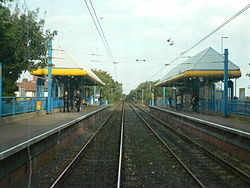List of Tyne and Wear Metro stations

The following is a list of Tyne and Wear Metro stations.
Purpose-built stations
The following stations were built specifically for the Tyne and Wear Metro system.
- Airport (opened 17 November 1991)
- Bank Foot (opened 10 May 1981)
- Bede (opened 24 March 1984)
- Byker (opened 14 November 1982)
- Callerton Parkway (opened 17 November 1991)
- Central Station (opened 15 November 1981)
- Chichester (opened 24 March 1984)
- Chillingham Road (opened 14 November 1982)
- Fawdon (opened 10 May 1981)
- Fellgate (opened 31 March 2002)
- Four Lane Ends (opened 11 August 1980)
- Gateshead (opened 15 November 1981)
- Gateshead Stadium (opened 15 November 1981) — called Old Fold in the planning stages
- Hadrian Road (opened 14 November 1982)
- Haymarket (opened 11 August 1980)
- Heworth (opened 15 November 1981)
- Ilford Road (opened 11 August 1980)
- Jesmond (opened August 11, 1980)
- Kingston Park (opened 15 September 1985)
- Manors (opened 14 November 1982)
- Meadow Well (opened 14 November 1982) — originally called Smiths Park, renamed 10 October 1994

Meadow Well Metro station in March 2005 - Millfield (opened 31 March 2002)
- Monument (opened 15 November 1981)
- Northumberland Park (opened 11 December 2005).
- Pallion (opened 31 March 2002)
- Palmersville (opened 19 March 1986)
- Park Lane (opened 28 April 2002)
- Pelaw (opened September 16, 1985; a previous station named Pelaw opened 18 November 1896 but was located north of the Metro site)
- Regent Centre (opened 10 May 1981)
- Simonside (opened 17 March 2008)
- St James (opened 14 November 1982)
- St Peter's (opened 31 March 2002)
- Shiremoor (opened 11 August 1980)
- South Hylton (opened 31 March 2002)
- South Shields (opened 24 March 1984)
- Stadium of Light (opened 31 March 2002)
- Tyne Dock (opened 24 March 1984)
- University (opened 31 March 2002)
- Wansbeck Road (opened 10 May 1981)
Converted stations

The following stations were built prior to the Metro system, but have since been converted or re-built for Metro use. All except Sunderland now serve Metro trains only.
This list does not include Fawdon, Bank Foot, and Regent Centre, which are located on the sites of the former Coxlodge, Kenton, and West Gosforth stations on what was once the Ponteland Railway, but which closed to passenger traffic in 1929; Pelaw, which was added to the Metro in 1985, and which is sited to the south of the former station of that name; Northumberland Park, opened 2005, built on the approximate site of the previous Backworth station, closed in 1979; and Palmersville, added in 1985, close to the short-lived Benton Square station (which was open 1909-1915). In addition, Jesmond, Manors, and Central Station are all purpose-built underground stations that were built near to, and share names with, previous suburban stations, and South Shields is built upon a bridge closer to the town centre than the previous mainline station of that name.
- Benton (opened March 1, 1871; Metro since August 11, 1980)
- Brockley Whins (formerly 'Boldon Colliery' as a heavy rail station) (Metro since March 31, 2002)
- Cullercoats (opened July 7, 1882; Metro since August 11, 1980)
- East Boldon (Metro since March 31, 2002)
- Felling (opened November 18, 1896; Metro since November 15, 1981)
- Hebburn (opened June 18, 1839; Metro since March 24, 1984)
- Howdon (opened June 18, 1839; Metro since November 14, 1982)
- Jarrow (opened March 1, 1872; Metro since March 24, 1984)
- Longbenton (opened July 14, 1947; Metro since August 11, 1980)
- Monkseaton (opened July 25, 1915; Metro since August 11, 1980)
- North Shields (opened 1890; Metro since November 14, 1982)
- Percy Main (opened June 18, 1839; Metro since November 14, 1982)
- Seaburn (Metro since March 31, 2002)
- South Gosforth (opened June 27, 1864; Metro since August 11, 1980; old station buildings demolished in late 1970s and replaced by Metro Control Centre)
- Sunderland (Metro since March 31, 2002 but still served by mainline trains)
- Tynemouth (opened July 7, 1882; Metro since August 11, 1980)
- Walkergate (opened June 19, 1839; Metro since November 14, 1982)
- Wallsend (opened June 19, 1839; Metro since November 14, 1982)
- West Jesmond (opened December 1, 1900; Metro since August 11, 1980)
- West Monkseaton (opened March 2, 1933; Metro since August 11, 1980)
- Whitley Bay (opened October 9, 1910; Metro since August 11, 1980)
Proposed stations
There have been numerous suggestions for infill stations on the Metro since it opened, and five of these, Pelaw, Kingston Park, Palmersville, Northumberland Park and Simonside have been built and attract high patronage. Other plans that have been abandoned or are yet to be built:
- Beaconsfield (between Tynemouth and Cullercoats): Proposed in the 1980s, but planned area development was abandoned
- Dorrington Road (west of Fawdon): In the planning stages, would thus probably have been called Fawdon, and today's Fawdon would have been called Coxlodge. The proposed station was sited where the Newcastle bypass road was ultimately built
- High Lane Row (between Hebburn and Jarrow): Construction to go ahead if the current single track is dualled. Both track dualling and this station are included in the latest proposals to central government
- Pallion Bridge (between South Hylton and Pallion): Proposed to be built when Ford Estate and the former Grove Cranes site are redeveloped for business and residential use, and the New Wear Bridge is completed, opening up new areas of patronage in the Castletown, Ford Estate, Hylton Riverside and Alexandra Park areas
- Stotts Road (between Walkergate and Wallsend): Proposed in the mid-1980s
- Victoria Road West (between Pelaw and Hebburn): Mooted by South Tyneside government officials in 2008. Currently, this is the longest stretch of track between two stations

